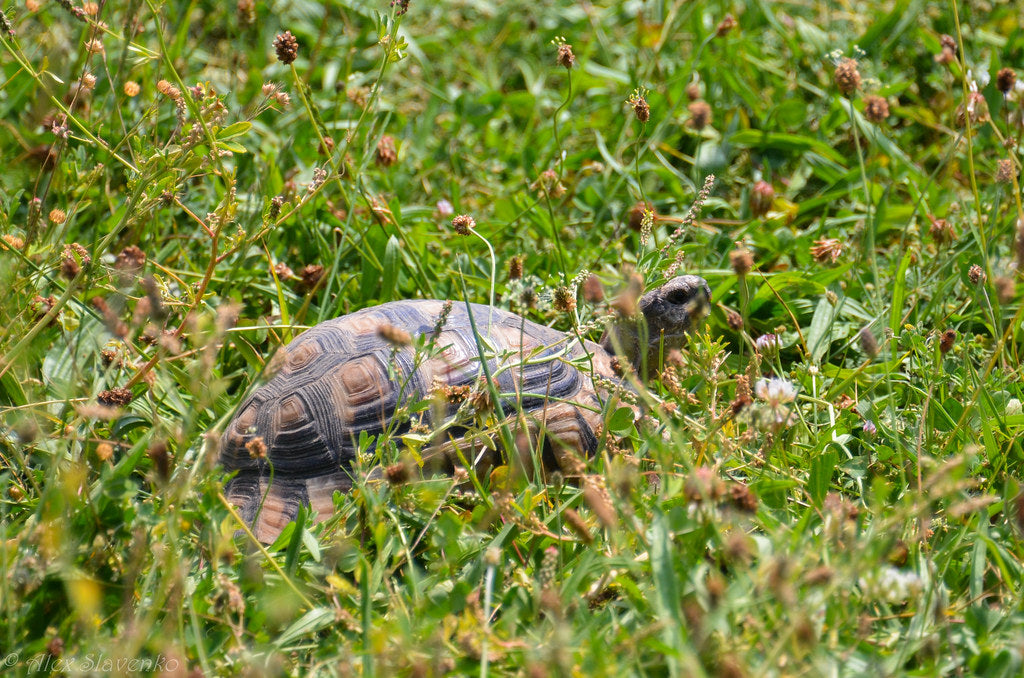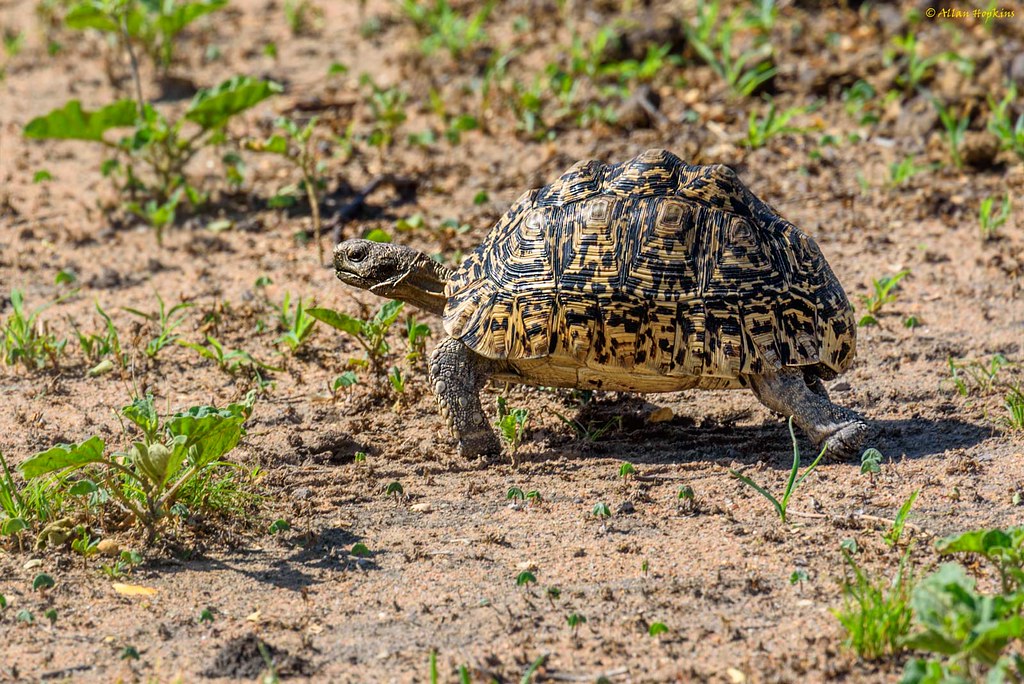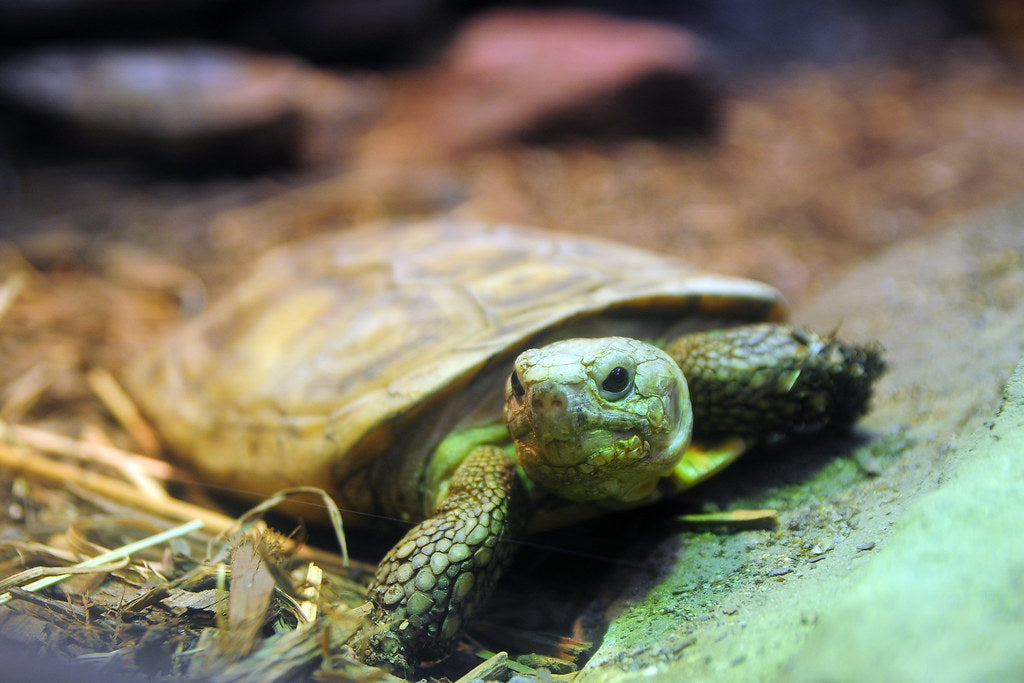Marginated tortoises (Testudo marginata) are medium-large tortoises native to Greece, Italy, and certain nearby islands. They prefer arid habitats such as evergreen scrub and rocky hillsides. Something that makes this species unique is that they can be found at elevations upto 5,000 feet!
Marginated tortoises can be as small as are generally 10-14” long, with females being smaller than the males. They have a highly domed shell with distinctively flared rear scutes that resemble a skirt. Their adult coloring is generally brown-black with cream to yellow highlights on the shell, and a creamy plastron with dark, triangular markings.
Marginated tortoises make hardy pets, but they’re a BIG commitment. Aside from their size, which generally requires housing outdoors, they also have remarkably long lifespans — with proper care, they may live beyond 100 years!
How much space do marginated tortoises need?
Marginated tortoises larger than 4” should ideally be housed outdoors for at least most of the year. They are very hardy, and it is easier to provide the space that they need outdoors than indoors. Housing a tortoise outdoors also makes heating and lighting much easier, as little to no equipment is required. Your tortoise pen should provide at least 100 square feet of floor space, but if you can provide larger, do it! They will certainly make good use of it. Walls should be at least 18” tall and extend at least 6” into the ground. Corners should be capped to further prevent escape, and predator-proofing measures should be in place.
For marginated tortoises smaller than 4”, it’s best to house them indoors. Young tortoises are more delicate and very susceptible to dehydration, and housing them in a terrarium of some kind makes it easier to keep track of them. Tortoises this small can be kept in a 3’ x 2’ enclosure while they grow.
If a temporary indoor enclosure is needed for adults due to poor weather during part of the year, it will essentially need to be the size of a small room.
Marginated tortoises can be successfully housed together, but it doesn’t seem to be required for their wellbeing. If you want to have more than one, you will need to increase the size of the enclosure.
Do marginated tortoises need UVB?
Yes. Aside from helping provide a day/night cycle and an infinite supply of vitamin D, UVB is also essential to your tortoise’s overall health. The best UVB bulbs for marginated tortoises are:
- Arcadia T5 HO 12%
- Zoo Med T5 HO Reptisun 10.0
The UVB bulb and fixture should be roughly half the total length of the enclosure. When the bulb is mounted in an Arcadia or Vivarium Electronics fixture without mesh obstruction, it should be 17-18” above the tortoise’s shell.
Because a large enclosure is required for marginated tortoises, if you are housing yours indoors, a single UVB bulb and your room’s ambient lighting will likely not be enough to sufficiently illuminate the enclosure. Add a strong 6500K LED or T5 HO fluorescent grow light to energize your tortoise and better simulate daylight
All lighting should be on for 14 hours/day during summer and 10 hours/day during winter.
If your tortoise is being housed outside and has access to direct sunlight, artificial lighting of any kind is not required.
What basking temperatures do marginated tortoises need?
Marginated tortoises should have a basking temperature around 95°F, with a cool/shaded area on the other side of the enclosure around 75°F. Heat should be turned off at night. Nighttime temps should not get higher than 72°F. Temperature should be measured with digital probe thermometers.
Because of their large, domed shells, it’s best to create a basking area for your marginated tortoise with a cluster of at least two halogen heat lamps placed on one side of the enclosure, mounted at least 8” above the tortoise’s shell to provide even heating. Do not use ceramic heat emitters (CHEs), heat mats, red bulbs, or blue bulbs, as these are not as effective.
Supplementary heating is usually not required for outdoor tortoise enclosures. However, if your nighttime temperatures are routinely dipping down below 50°F, then it’s a good idea to provide a small tortoise shelter heated to 55-60°F.
What humidity levels do marginated tortoises need?
Adult marginated tortoises do best with a fairly dry environment with access to humid microclimates. One of the best ways to do this is by offering a humid hide lined with dampened substrate or sphagnum moss on the cool end of the enclosure.
However, hatchlings and juveniles dehydrate more easily and require ambient humidity levels around 60% for proper hydration and shell development, plus access to an area of 80%+ humidity. However, your tortoise’s enclosure should never be consistently wet, as this can cause skin, shell, and respiratory problems!
To increase ambient humidity levels, you can mist the enclosure with a spray bottle each evening, but it’s most effective to mix water directly into the substrate.
Humidity should be measured by a digital probe hygrometer with the probe in the middle of the terrarium.
What substrate is good for marginated tortoises?
Substrate covers the floor of your enclosure and helps make the setup more attractive, but it also helps maintain higher humidity levels and provides something for your tortoise to dig in as desired.
It’s ideal to use a substrate that imitates what marginated tortoises naturally live on in the wild. In other words, you’ll need something that resembles sandy soil. It should have small particles, not be too dusty, and pack well enough for burrowing.
The best substrate for a marginated tortoise is a roughly 50/50 mix of topsoil and play sand, which you can mix yourself using ingredients sourced for cheap from your local landscaping supply store. For best results, layer ~2” of cypress mulch on top.
Substrate should be 2-4” deep for juveniles and fully replaced every 3-4 months. Remove poop and urates daily, along with contaminated substrate.
Marginated tortoises housed outdoors should be on a sandy soil substrate, not grass lawn.
What décor can you use in a marginated tortoise enclosure?
It’s terribly boring for a tortoise to be stuck in an enclosure with nothing in it except substrate, a hide, and food/water bowls. It doesn’t matter how big the enclosure is if you don’t put things in it for your pet to use and interact with. A bored tortoise is a stressed tortoise, and stress can be lethal.
Here are some décor ideas that are appropriate for marginated tortoises:
- additional hiding places/burrows
- large hollow logs
- cork flats
- live, edible plants (see The Tortoise Table)
- large, flat stones
It’s a good idea to shape the substrate into hills to provide an extra challenge.
What do marginated tortoises eat?
Marginated tortoises are herbivorous, which means that they require a high-fiber diet. Food should be offered daily. If your tortoise is starting to look chubby (like it doesn’t fit in its own shell), reduce the amount of food that you offer per day.
Safe greens for marginated tortoises: cactus pads, kale, turnip greens, mustard greens, dandelion greens + flowers, hibiscus leaves + flowers, nasturtium, alfalfa, clover, coreopsis, geranium, grape leaves, green cabbage, kale, radicchio, chicory, watercress, fennel, sprouts, endive, radish greens
Greens should make up the majority of your tortoise’s diet. Vegetables can be offered as well, but these should be used only as treats, offered 1x/week or less. Options include squash, cucumber, mushrooms, peas, beans, and carrot.
Fruit should be extremely rare, if offered at all.
Supplements
You will also need calcium and vitamin supplements to prevent your tortoise from developing a potential deficiency. A little bit of Mazuri grassland tortoise formula or Zoo Med Natural Grassland Tortoise Food mixed in with the greens is a good way to make sure your tortoise is getting enough vitamins.
To help keep the beak trimmed and make sure your tortoise is getting enough calcium, keep a cuttlebone in the enclosure at all times. Your tortoise will gnaw on it whenever it feels like it needs more calcium.
Water
Of course, don’t forget a water dish for your tortoise to drink from! Use a very shallow dish of water like a flower pot saucer or baking tray for this. The water should be no deeper than your tortoise’s elbows.
Change the water daily and scrub the bowl with a reptile-safe disinfectant weekly.
Hatchling and juvenile marginated tortoises under 4” should be soaked in shallow, lukewarm water daily for 15-20 minutes per session to prevent dehydration.
Do marginated tortoises like to be handled?
Few reptiles actually “like” to be held, and as a general rule, it’s a bad idea to pick up a pet tortoise and carry them around. Marginated tortoises generally tolerate human interaction well, especially individuals that were bred in captivity. If you want to interact with your pet, try hand-feeding it or lightly brushing its shell.
If you need to handle your tortoise, never grab a tortoise from above, as that will scare it. Instead, approach from the side and scoop from below. Support as much of its body as possible and keep the handling period to a minimum.
*This care sheet contains only very basic information. Although it’s a good introduction, please do further research with high-quality sources to obtain additional information on caring for this species.
"Testudo marginata" by alexslavenko is licensed under CC BY-NC-SA 2.0




Leave a comment
This site is protected by hCaptcha and the hCaptcha Privacy Policy and Terms of Service apply.